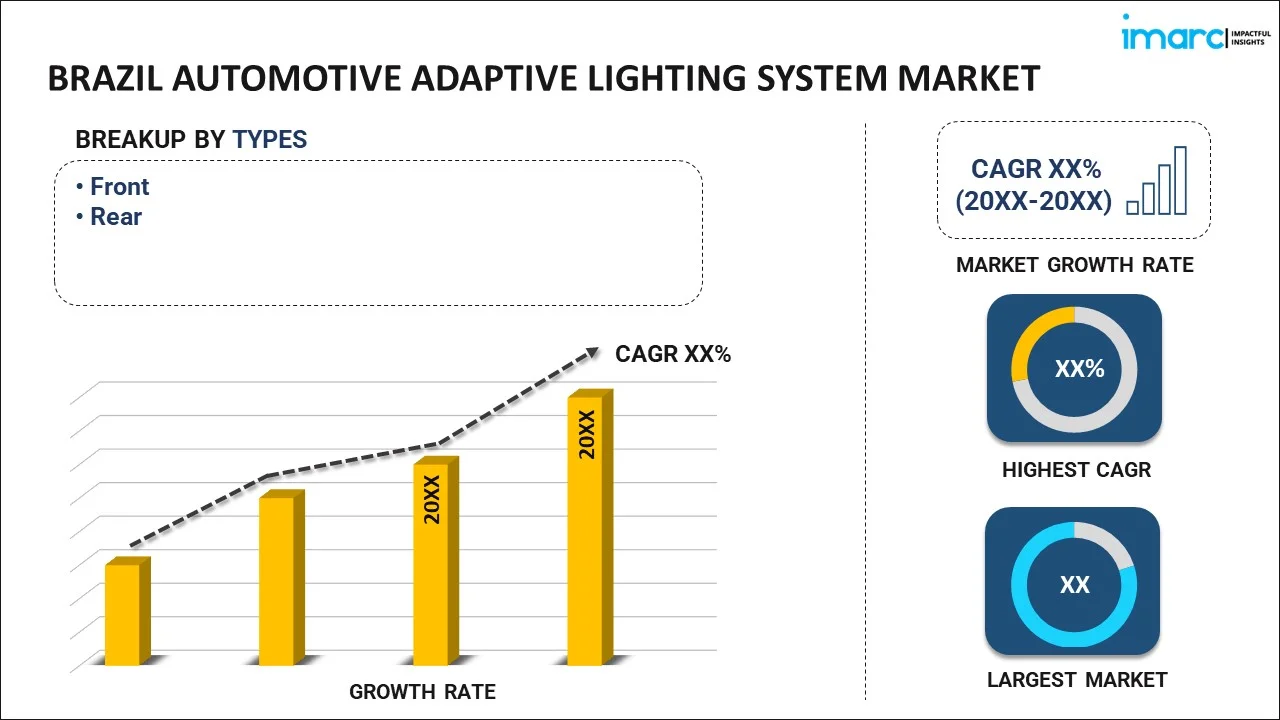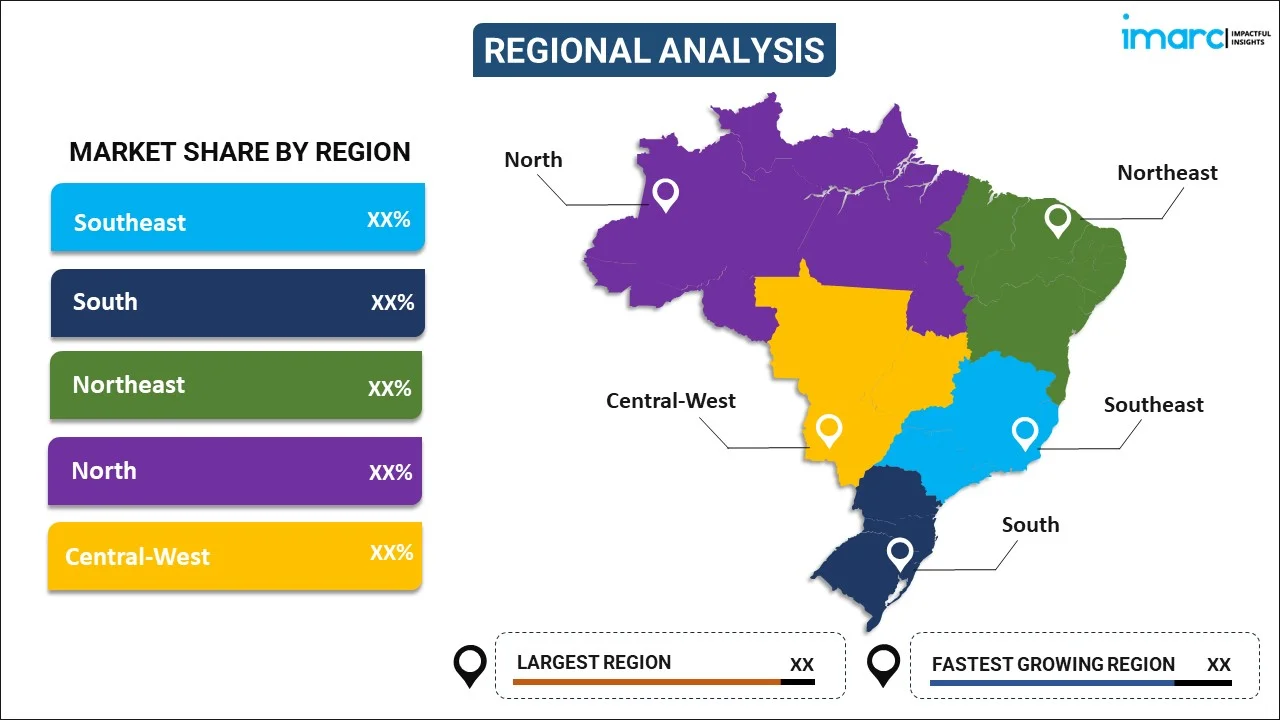
Brazil Automotive Adaptive Lighting System Market Report by Type (Front, Rear), Vehicle Type (Mid-Segment Passenger Vehicles, Sports Cars, Premium Vehicles), Sales Channel (OEM, Aftermarket), and Region 2025-2033
Market Overview:
Brazil automotive adaptive lighting system market size reached USD 33.9 Million in 2024. Looking forward, IMARC Group expects the market to reach USD 55.0 Million by 2033, exhibiting a growth rate (CAGR) of 5.5% during 2025-2033. The growing automotive sector in the country, rising focus on sustainable and eco-friendly solutions, sudden shift towards electric and hybrid vehicles, rapid technological advancements, ongoing research and development (R&D), and the implementation of stringent government regulation represent some of the key factors driving the market.
|
Report Attribute
|
Key Statistics
|
|---|---|
|
Base Year
|
2024 |
|
Forecast Years
|
2025-2033
|
|
Historical Years
|
2019-2024
|
| Market Size in 2024 | USD 33.9 Million |
| Market Forecast in 2033 | USD 55.0 Million |
| Market Growth Rate (2025-2033) | 5.5% |
Automotive adaptive lighting systems (AALS) refer to advanced lighting solutions employed in vehicles to improve visibility during various driving conditions. They adjust the beam direction and intensity based on factors like vehicle speed, type of road, steering angle, and driving style. Automotive adaptive lighting systems include dynamic bending light, glare-free high beams, and adaptive front lighting. They offer enhanced illumination for night driving, cityscape, highways, and sharp curves. Automotive adaptive lighting systems are utilized in passenger cars, light trucks, sport utility vehicles (SUVs), electric vehicles (EVs), hybrids, sports cars, luxury vehicles, commercial trucks, buses, and off-road vehicles. They offer numerous benefits, including improved night-time visibility, enhanced safety, reduced glare, better energy efficiency, increased lifespan, adaptability in diverse conditions, and excellent performance in adverse weather conditions. Additionally, automotive adaptive lighting systems provide advantages, such as real-time adaptability, seamless integration with vehicle sensors, optimal illumination, support for autonomous driving advancements, durability, reduced carbon dioxide emissions, user-friendliness, and energy conservation.
Brazil Automotive Adaptive Lighting System Market Trends:
The growing automotive sector in the country, leading to the increasing adoption of advanced automotive systems like AALS, is one of the major factors stimulating the market growth. Besides this, the rising urbanization, coupled with the increasing middle-class population, propelling the demand for luxury and high-end vehicles equipped with adaptive lighting technologies is favoring the market growth. Additionally, the growing adoption of AALS due to its ability to enhance night-time visibility and reduce accidents is strengthening the market growth. Moreover, the rising focus on sustainable and eco-friendly solutions, leading to the widespread technology adoption due to its energy efficiency and reduced carbon footprint, is supporting the market growth. Furthermore, the sudden shift towards electric and hybrid vehicles in the country, prioritizing energy conservation, is favoring the market growth. Along with this, rapid technological advancements, coupled with research and development (R&D) in the automotive sector, propelling the evolution of AALS, are bolstering the market growth. In line with this, the integration of AALS with sensors, the Internet of Things (IoT), and artificial intelligence (AI), enhancing real-time adaptability, is positively impacting the market growth. Apart from this, the introduction of autonomous and connected vehicles, necessitating the adoption of advanced systems like AALS, is fueling the market growth. Additionally, the rising influx of foreign investments and the establishment of manufacturing units by global automotive companies in Brazil, facilitating technology transfer, is providing a thrust to the market growth. Besides this, the establishment of stringent government regulations, propelling manufacturers to incorporate advanced lighting systems like AALS to meet vehicle safety regulations while providing optimal driving conditions, is offering lucrative growth opportunities for the market.
Brazil Automotive Adaptive Lighting System Market Segmentation:
IMARC Group provides an analysis of the key trends in each segment of the market, along with forecasts at the country level for 2025-2033. Our report has categorized the market based on type, vehicle type, and sales channel.
Type Insights:

- Front
- Rear
The report has provided a detailed breakup and analysis of the market based on the type. This includes front and rear.
Vehicle Type Insights:
- Mid-Segment Passenger Vehicles
- Sports Cars
- Premium Vehicles
A detailed breakup and analysis of the market based on the vehicle type have also been provided in the report. This includes mid-segment passenger vehicles, sports cars, and premium vehicles.
Sales Channel Insights:
- OEM
- Aftermarket
The report has provided a detailed breakup and analysis of the market based on the sales channel. This includes OEM and aftermarket.
Regional Insights:

- Southeast
- South
- Northeast
- North
- Central-West
The report has also provided a comprehensive analysis of all the major regional markets, which include Southeast, South, Northeast, North, and Central-West.
Competitive Landscape:
The market research report has also provided a comprehensive analysis of the competitive landscape in the market. Competitive analysis such as market structure, key player positioning, top winning strategies, competitive dashboard, and company evaluation quadrant has been covered in the report. Also, detailed profiles of all major companies have been provided.
Brazil Automotive Adaptive Lighting System Market Report Coverage:
| Report Features | Details |
|---|---|
| Base Year of the Analysis | 2024 |
| Historical Period | 2019-2024 |
| Forecast Period | 2025-2033 |
| Units | Million USD |
| Scope of the Report | Exploration of Historical and Forecast Trends, Industry Catalysts and Challenges, Segment-Wise Historical and Predictive Market Assessment:
|
| Types Covered | Front, Rear |
| Vehicle Types Covered | Mid-Segment Passenger Vehicles, Sports Cars, Premium Vehicles |
| Sales Channels Covered | OEM, Aftermarket |
| Regions Covered | Southeast, South, Northeast, North, Central-West |
| Customization Scope | 10% Free Customization |
| Post-Sale Analyst Support | 10-12 Weeks |
| Delivery Format | PDF and Excel through Email (We can also provide the editable version of the report in PPT/Word format on special request) |
Key Questions Answered in This Report:
- How has the Brazil automotive adaptive lighting system market performed so far and how will it perform in the coming years?
- What has been the impact of COVID-19 on the Brazil automotive adaptive lighting system market?
- What is the breakup of the Brazil automotive adaptive lighting system market on the basis of type?
- What is the breakup of the Brazil automotive adaptive lighting system market on the basis of vehicle type?
- What is the breakup of the Brazil automotive adaptive lighting system market on the basis of sales channel?
- What are the various stages in the value chain of the Brazil automotive adaptive lighting system market?
- What are the key driving factors and challenges in the Brazil automotive adaptive lighting system?
- What is the structure of the Brazil automotive adaptive lighting system market and who are the key players?
- What is the degree of competition in the Brazil automotive adaptive lighting system market?
Key Benefits for Stakeholders:
- IMARC’s industry report offers a comprehensive quantitative analysis of various market segments, historical and current market trends, market forecasts, and dynamics of the Brazil automotive adaptive lighting system market from 2019-2033.
- The research report provides the latest information on the market drivers, challenges, and opportunities in the Brazil automotive adaptive lighting system market.
- Porter's five forces analysis assist stakeholders in assessing the impact of new entrants, competitive rivalry, supplier power, buyer power, and the threat of substitution. It helps stakeholders to analyze the level of competition within the Brazil automotive adaptive lighting system industry and its attractiveness.
- Competitive landscape allows stakeholders to understand their competitive environment and provides an insight into the current positions of key players in the market.
Need more help?
- Speak to our experienced analysts for insights on the current market scenarios.
- Include additional segments and countries to customize the report as per your requirement.
- Gain an unparalleled competitive advantage in your domain by understanding how to utilize the report and positively impacting your operations and revenue.
- For further assistance, please connect with our analysts.
 Inquire Before Buying
Inquire Before Buying
 Speak to an Analyst
Speak to an Analyst
 Request Brochure
Request Brochure
 Request Customization
Request Customization




.webp)




.webp)












